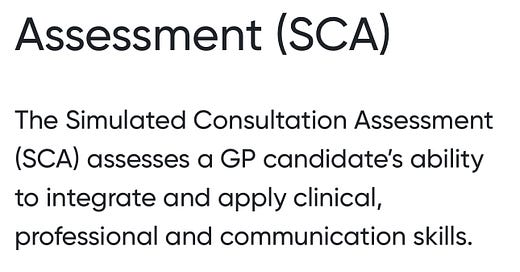This One’s for the SCA Warriors in GP Training
Preparing for the (oft dreaded) SCA as a GP Registrar? Some tips for acing it!
The SCA is a challenging exam and is getting more complex with the College adding more complexity and information to the exam cases. Here we focus on one of the three domains tested in the exam: Data Gathering and Diagnosis.
‘Communication is an art and you’re the artist. Let it flow naturally and it’ll all come alive in front of your eyes!’
Data Gathering and Diagnosis
➡️ Introduction: Opening the consultation
Everyone has their unique way of introducing themselves, with their own style. It's generally recommended to introduce yourself as Dr (Surname) or Dr (First name, Surname), rather than using just your first name.
At this point in the consultation, ensure that you start with an open-ended question, paying close attention to any cues the patient might give. I’ve noticed that almost EVERY SINGLE case provides at least one cue early in the consultation.
Make sure to clarify at this stage what the patient is presenting with and ask if there are any other issues they’d like to discuss during the appointment.
➡️ Suggestions for the start of the consultation:
Avoid switching to closed questions too early. Try to keep the conversation open for as long as possible.
For example, here’s how some doctors might begin a consultation:
Doctor: Hello, what’s brought you in today?
Patient: Well, I’ve developed this really bad pain in my stomach, and it’s making me feel a little nauseous.
Doctor: How long ago did the pain start?
In this example, the doctor has prematurely closed off the consultation. A much better approach would be:
Doctor: Hello, what’s brought you in today?
Patient: Well, I’ve developed this really bad pain in my stomach, and it’s making me feel a little nauseous.
Doctor: How did the pain begin?
By using a more open-ended question, the doctor gives the patient a chance to provide more detailed and free-flowing information.
➡️ History Taking: A Structured Approach
Having a well-organised structure for history taking is essential. The following structure tends to be effective:
- Presenting complaint
- Cue Handling
- History of presenting complaint
- Past medical history
- Medication history/allergies
- Family history
- Social history (smoking, alcohol, drugs, occupation & driving), including the new “psychosocial context” heading
- Ideas, concerns, and expectations
- Impact on quality of life
This framework helps ensure you don't miss any key information.
New to the SCA is this marking criterion:
"Effectively utilises available information about the problem and its broader context."
We know that before every case, you'll have 3 minutes to review the patient summary. The RCGP will now include more detailed information in the medical summary compared to past exams, often incorporating prior consultations, test results, and findings from other healthcare providers. Carefully reviewing and utilising this information is essential for running a smooth, efficient consultation.
➡️ Cue Handling: Navigating the Consultation
Cues are arguably the most critical aspect to master in the SCA. While the above history-taking structure is a reliable foundation, sticking to it strictly may not always be feasible.
🚨 A key point to remember: **there are no irrelevant cues**—if a patient mentions something, it’s there for a reason. Remember, the cases you’ll handle in the SCA are planned and refined beforehand. Any cue that surfaces must be addressed.
Within the presenting complaint, each case will present a cue you need to address. The question then becomes, how should you handle these cues? ⬇️
There are two ways to approach this:
1. You can "park" the cue:
"I noticed you mentioned... I'd like to revisit that later if that's okay?"
2. Or, you can deal with the cue immediately:
"I noticed you mentioned... Could you tell me more about that?"
Neither approach is inherently right or wrong (except for ignoring the cue!). Addressing cues as they arise is often the easiest way to quickly uncover the patient’s ideas, concerns, and expectations.
Once you’ve fully explored the cue, you can return to the structured framework to gather any remaining information. If you decide to park the cue, be sure to circle back to it later!
**REMEMBER: No Means No**
This advice is straightforward: When a patient says no, it means no! If you ask about something that leads to a dead-end or follow up on something you thought was a cue but isn’t, the patient will likely let you know there’s nothing more to say on the matter, often in very clear terms.
Don’t waste time pursuing a line of questioning that won’t yield results—it will lead nowhere and eat up valuable time.
In the next issue I will focus on the next domain that is tested in the SCA: Clinical management and medical complexity (CM&C).



